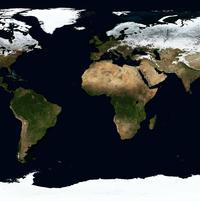Since I started my academic career, my interests have always been in the field of landscape ecology. I study the relationships between ecological processes, such as habitat selection for animal and plant species, selection of migratory routes for single individuals, and landscape features. Specifically, the relationships are usually assessed between georeferenced points (i.e. points with geographic coordinates that can be displayed on a Cartesian plane) which are used to represent the ecological process being studied, and produce digitized maps of the landscape.
In may work the georeferenced points are associated with the presence and absence of animal species detected in a certain area, either by static camera traps or tracking with radio-collars. The maps we produce are composed of digitized layers depicting, at different scales and resolutions, various characteristics of the study area, such as land cover features (e.g., forest cover, croplands, human settlements), topographic features (e.g., elevation, slope, roughness), climatic features (e.g., temperature, precipitation), or anthropic features (e.g., forest loss, human population density, human footprint).
This allows us to quantify the relationships between the ecological process studied and specific landscape features. By applying mathematical and statistical models to the data, we can assign a coefficient to each landscape feature, which describes the intensity and direction of their impact on the ecological process (i.e., positive or negative, weak or strong). The end-product of the assessment is usually a spatially explicit representation of the ecological process and a set of projections which model the probability of the ecological process occurring over a wider study area or a different timescale. So, for example, we could model the various environmental factors determining the suitability of the habitat for a particular species, and then use the model to assess how the distribution of the species is likely to change over some future time frame - say 5 years. Another application would be to define the factors driving the dispersal of individual members of a species within a given area, and project the model onto a wider study area to highlight the routes that individuals are likely to take for in migration.
It should be clear that a fundamental requirement for the work of landscape ecologists is spatially explicit data on (i) the ecological process being studied and (ii) on the landscape features thought to influence it. Without such data, it would be impossible to relate ecological processes with landscape features so as to underpin model-building for projections.
Recently, I went through a revision of the available data describing demographic, social and economic changes in Southeast Asia over the coming years with a view to using the data to describe factors potentially affecting the biodiversity in the region. Spatially explicit projections of human population dynamics are fundamental factors to take into account in climate and global environment change research. Spatial projections for human settlements are needed for projections of urban land cover and agricultural land. They would also tell us about the vulnerability of different populations to impacts such as sea level rise and earthquakes. For my research project I have been looking for usable human population projections in order to model how the biodiversity is likely to be affected in the future under demographic and socio-economic changes.
What the review showed me is how difficult it is to find spatially explicit demographic and socio-economic data for human populations. The projections that are available for future fertility and mortality rates, for migration and population growth mostly cover geographical areas at a very coarse level of resolution, and almost none of this information is available in a spatially explicit format. These limitations have brought home to me the distance between the ecological and social sciences. They hamper multidisciplinary research and communication across what should be connected fields of inquiry, and undermine the possibility of getting more accurate assessments and projections.
I did, however, have the good fortune to fine one very interesting and potentially helpful study produced in 2016 by a demographer and a geophysicist. The aim was to produce global, spatially explicit, fine scale projections of the human population in 10-years intervals up to 2100. Not only that, but they accounted for some key uncertainties in the population dynamics by producing scenarios consistent with the Shared Socioeconomic Pathways (SSPs). These consist of five alternative outcomes for current megatrends in demography, economics, technology development, lifestyle, governance and other societal factors. The SSPs combine qualitative narratives of future development with quantitative projections of that include national level population growth and educational composition, urbanization and economic growth. The scenarios are characterized by
sustainability (SSP1 - ‘taking the green road’),
regional rivalry (SSP3 – ‘a rocky road’)
inequality (SSP4 – ‘a road divided’)
fossil-fuel development (SSP5 – ‘taking the highway’).
SSP2 is constructed as a middle of the road scenario.
Although the authors concede that the study has major limitations (the potential effects of climate change on demographic and social dynamics are not taken into account, which might lead to alternative population and urbanization outcomes), it represents one of the first and most successful attempts to incorporate different development scenarios into human population projections.
For me, this line of research represents a major achievement in moving towards a more interdisciplinary view of ecological, demographic and social issues. I should emphasise that that the studies I have discussed here have not been picked out from a comprehensive review. I mention them because they have been helpful for my research, not because they are necessarily the best available studies with the most relevant models. So if anyone has any advice or comments on this blog post that would help me find more spatially explicit demographic and socio-economic models, then please do get in touch.
About the Author
Luca Chiaverini is a DPhil candidate at the Departmetn of Zoology. His research examines scenarios of biodiversity conservation in Southeast Asia under future land-use and socio-economic changes
Comments Welcome
We welcome your comments on this or any of the Institute's blog posts. Please feel free to email comments to be posted on your behalf to administrator@ageing.ox.ac.uk or use the Disqus facility linked below.
Opinions of the blogger is their own and not endorsed by the Institute
Comments Welcome: We welcome your comments on this or any of the Institute's blog posts. Please feel free to email comments to be posted on your behalf to administrator@ageing.ox.ac.uk or use the Disqus facility linked below.













